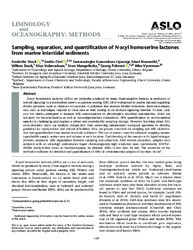Sampling, separation, and quantification of N‐acyl homoserine lactones from marine intertidal sediments
Nuwanthi, Samarasinghe Gunasekara Liyanage Ishari
Stock, Willem
Ueberschaar, Nico
Mangelinckx, Sven
Vyverman, Wim
Stock, Frederike; Cirri, Emilio; Nuwanthi, Samarasinghe Gunasekara Liyanage Ishari; Stock, Willem; Ueberschaar, Nico; Mangelinckx, Sven; Pohnert, Georg; Vyverman, Wim, 2021: Sampling, separation, and quantification of N‐acyl homoserine lactones from marine intertidal sediments. In: Limnology and Oceanography: Methods, Band 19, 2: 145 - 157, DOI: 10.23689/fidgeo-4220.
 |
Dokument öffnen: |
N‐acyl homoserine lactones (AHLs) are molecules produced by many Gram‐negative bacteria as mediators of cell‐cell signaling in a mechanism known as quorum sensing (QS). QS is widespread in marine bacteria regulating diverse processes, such as virulence or excretion of polymers that mediate biofilm formation. Associated eukaryotes, such as microalgae, respond to these cues as well, leading to an intricate signaling network. To date, only very few studies attempted to measure AHL concentrations in phototrophic microbial communities, which are hot spots for bacteria‐bacteria as well as microalgae‐bacteria interactions. AHL quantification in environmental samples is challenging and requires a robust and reproducible sampling strategy. However, knowing about AHL concentrations opens up multiple perspectives from answering fundamental ecological questions to deriving guidelines for manipulation and control of biofilms. Here, we present a method for sampling and AHL identification and quantification from marine intertidal sediments. The use of contact cores for sediment sampling ensures reproducible sample surface area and volume at each location. Flash‐freezing of the samples with liquid nitrogen prevents enzymatic AHL degradation between sampling and extraction. After solvent extraction, samples were analyzed with an ultra‐high performance liquid chromatography‐high resolution mass spectrometry (UHPLC‐HRMS) method that allows to baseline‐separate 16 different AHLs in less than 10 min. The sensitivity of the method is sufficient for detection and quantification of AHLs in environmental samples of less than 16 cm3.
Statistik:
ZugriffsstatistikSammlung:
This is an open access article under the terms of the Creative Commons Attribution License, which permits use, distribution and reproduction in any medium, provided the original work is properly cited.

